“Becoming profoundly deaf at the age of seven shaped my perspective and gave me a unique understanding of the challenges faced by the Deaf Community,” John Patrick Doherty, Chaplain for the Deaf Community in Munster told The Irish Catholic.
Mr Doherty believes that was God’s way to prepare him to serve others with compassion and empathy. “My faith and spirituality gave me the confidence to embrace this calling, and I feel truly honoured to serve as a lay chaplain for the Deaf Community in Munster.”
He said that by growing up as a deaf person, he could understand firsthand “the struggles and barriers that can sometimes make it difficult for members of the Deaf Community to fully participate in the life of the Church.” He saw the opportunity to “help bridge that gap, to ensure that no one feels excluded from the sacraments, the liturgy, or the love of Christ,” by becoming a lay chaplain.
Journey
Working as chaplain since 2013, his career journey started much earlier, when he worked in a deaf school in Africa for five years. That time “was one of the greatest privileges of my life. It was a journey of learning, understanding, and growing,” he said.
For Mr Doherty, “teaching the deaf children was nothing short of amazing, and it deepened my faith and sense of purpose in ways I could never have imagined… This experience taught me that love and faith transcend all barriers, including those of language and circumstance.
“It reminded me of the Church’s mission to be a home for all, especially the most vulnerable. As Pope Francis often says, we are called to go to the peripheries, to accompany those on the margins of society, and to bring them the love of Christ. My time at the deaf school was a living example of this call, and I am forever grateful for the opportunity to serve in this way.”
Facing the struggles and challenges of communications during his early years in mainstream education, Mr Doherty found comfort and strength “in my strong soul. This deep sense of God’s presence has been a constant source of peace and reassurance, guiding me through life’s difficulties and preparing me for the ministry I am privileged to carry out today.”
His job in the chaplaincy influences Mr Doherty’s own faith”
As part of his journey, he pursued qualifications in Clinical Pastoral Education (CPE). “Through CPE, I gained valuable skills in providing pastoral care with greater sensitivity and attentiveness to the spiritual and emotional needs of those I serve,” he said. He also completed a master’s in theology at St Patrick’s College, Maynooth.
As a chaplain, Mr Doherty’s role is to assist members of the deaf community on their spiritual journey, “offering them pastoral care, support, and access to the sacraments.”
He interprets liturgies in sign language, provides catechesis and provides them necessary resources to nourish their faith. It “also involves simply being present listening, offering encouragement, and walking with people through the joys and challenges of life… One of the most important aspects of my work is fostering a sense of inclusion and belonging.”
His job in the chaplaincy influences Mr Doherty’s own faith. “It has taught me to see Christ in every person and to trust in His providence, even in the face of challenges, he said. It “has shown me the beauty of diversity within the Body of Christ and the importance of inclusion and compassion.
Collaboration
“As a chaplain, I am constantly drawing strength from the Eucharist and from my own relationship with God. This work has brought me closer to Him and has helped me to grow in humility, gratitude, and love.”
The way Mass is celebrated for the Deaf Community can vary, Mr Doherty explained. It depends on “the resources and the priest’s abilities.” Sometimes, the priest knows Irish Sign Language (ISL) and will celebrate Mass himself, others he depends on qualified ISL interpreters’ assistance to ensure the deaf community can fully participate in the liturgy.
Small efforts like these reflect the Church’s mission to include everyone”
“In Munster, where I work closely with priests during Deaf Masses, the approach is often collaborative,” he said. “Typically, the priest celebrates the Mass speaking, while I interpret the liturgy into ISL. This collaboration is essential to ensure that the beauty and depth of the Mass are accessible to all.”
Technology is also a useful tool in making Mass accessible, he explained. “I use speech-to-text technology to follow along with the priest’s words, and we work together closely to ensure accuracy and clarity.”
For the chaplain, “it is absolutely imperative that liturgies are accessible, particularly for the deaf community, for whom ISL is their first language.”
“Accessibility is not just a matter of convenience,” he explained. “It is a matter of inclusion, dignity, and the Church’s mission to bring the Gospel to all people.”
“The Church teaches that the liturgy is the ‘source and summit of the Christian life’ [Sacrosanctum Concilium, 10],” Mr Doherty said. “This truth applies to every member of the Body of Christ, including the deaf and hard of hearing.”
Accessibility
He explained that “when liturgies are inaccessible, the deaf community is effectively excluded from the fullness of the Church’s worship and sacramental life. This is why it is so important to provide interpreters, priests who are trained in sign language, and chaplains like myself who can bridge the gap and ensure that the beauty and richness of the liturgy are accessible to all.”
One of the challenges in making the Church life accessible, is “ensuring that the deaf community has full access to the sacraments and the life of the Church. This requires ongoing efforts to provide resources, training, and support, not only for the deaf but also for those who minister to them. Communication can also be a barrier, especially in areas where sign language is not widely used or understood.”
As St Paul says, ‘Let all things be done for edification’”
When ISL is not available, used or understood, there needs to be alternatives to make Mass more accessible. “One effective option is using speech-to-text software to display the prayers, readings, and homily on a monitor or screen in real time,” Mr Doherty said. “This allows deaf and hard-of-hearing individuals to follow along.”
Another alternative would be the priests emphasising “gestures and symbols, like the Sign of the Cross or the elevation of the Eucharist, which communicate meaning visually,” he said.
“Even small efforts like these reflect the Church’s mission to include everyone in the liturgy. As St Paul says, ‘Let all things be done for edification’ (1 Corinthians 14:26)”
Experience
Every person experience God in unique ways during the liturgy. “For those of us who are deaf, the Holy Spirit often speaks to us through what we see and feel,” the chaplain explained.
“This is where Visio Divina, the prayerful contemplation of sacred images, becomes so important. Stained glass windows, the Stations of the Cross, the gestures of the priest, and the beauty of the Eucharistic elevation—all of these are like visual prayers. They draw us into the mysteries of Christ’s life, death, and resurrection.”
When a blind person attends Mass, even if they cannot see the Holy Spirit, they can ‘feel’ Him in their heart. Similarly, a deaf person can ‘see’ His presence in the sacred symbols and images.
The chaplain believes it’s important to recognise “how the Church, as the Body of Christ, is enriched by the diversity of its members. Whether someone is deaf, blind, has a disability, or faces any other challenge, each person brings unique gifts to the Church,” he said. “Every member of the Body of Christ is indispensable, and the Church becomes more beautiful and complete when everyone is included.
Those who have a disability have much to teach the Church about faith”
“For the deaf community, this means embracing the richness of visual prayer, sacred art, gestures in the liturgy, and even the physical and sensory aspects of worship. For example, the smell of incense during Mass can be a profound experience. The rising smoke of incense is a visual and sensory representation of our prayers ascending to God,” Mr Doherty explained.
“For those who cannot hear the prayers or music, the fragrance of incense becomes another way to feel connected to the sacred mysteries… For the blind, deaf, or anyone with sensory differences, these elements of the liturgy become powerful ways to encounter the Holy Spirit.”
Those who have a disability have much to teach the Church about faith, Mr Doherty believes. “Silence, stillness, and contemplation are gifts that can deepen our relationship with God. The deaf, for example, can teach others to ‘listen’ with their hearts and to see God’s presence in ways that go beyond words or sound. Likewise, the blind can guide others in trusting God’s light even when they cannot physically see it.”
Witness
Mr Doherty invites people to reflect on how they can help their parishes to become more inclusive. “Whether it’s advocating for accessible liturgies, learning more about the needs of the deaf and blind communities, or simply fostering a spirit of welcome and understanding, each of us can play a role in building a Church that truly reflects the love of Christ.”
Each September, he takes part of the sick pilgrimage from Dublin to Lourdes. Deaf pilgrims from all across Ireland join the “sacred journey”, when Mr Doherty goes not only as a chaplain, but also as a helper.
“It is truly a blessing to witness the deaf community come together in Lourdes, especially those who may feel isolated—whether they are living on their own, in care homes, or in situations where they struggle to connect with others spiritually.”
It is important to make every person to feel included”
“For me, being part of this pilgrimage is a reminder of the Church’s universality,” he explained. “In Lourdes, we see the Body of Christ in action—each person, whether deaf, hearing, sick, or helper, plays a vital role in creating a community of faith, hope, and healing.” For the chaplain, it is a privilege to serve and to witness “how Our Lady of Lourdes continues to intercede for all of us, especially those who carry heavy burdens.”
For Mr Doherty, “The deaf and hearing helpers themselves are a testament to the beauty of service. Their willingness to give their time, energy, and love reflects the Gospel message of caring for the most vulnerable.”
Besides caring, it is important to make every person to feel included and one of the ways of doing that is to making sure they can understand that preaching and prayers.
Making liturgies accessible, “are not just practical but deeply evangelistic, embodying the Church’s universal mission. As Pope Francis reminds us in Evangelii Gaudium, the Church must go forth to include those on the peripheries. By embracing these tools, we ensure that no one is excluded from the joy of the Gospel.”
“Inclusion is not just a practical matter—it is a theological one,” the chaplain explained. “The Church is called to reflect the love of Christ, who reached out to all people… By prioritising accessible liturgies and embracing advancements in technology, we can ensure that the deaf community feels fully included in the life of the Church. This is not just about accessibility—it is about belonging. It is about proclaiming, in word and in action, that the Gospel is for everyone.”
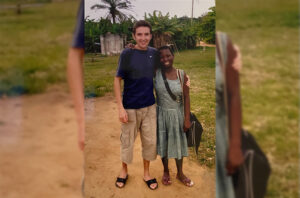
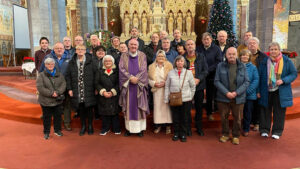
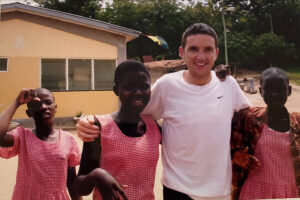


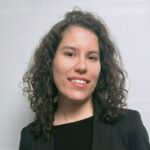 Renata Steffens
Renata Steffens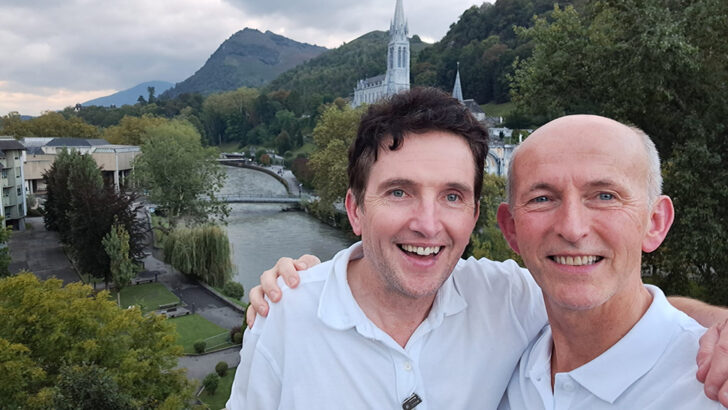 Mr Doherty and Fergus Dunne (Helper) in a moment of reflection at the top of the Accueil (Hospital) building in Lourdes.
Mr Doherty and Fergus Dunne (Helper) in a moment of reflection at the top of the Accueil (Hospital) building in Lourdes. 